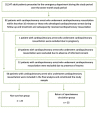Serum SCUBE-1 Levels and Return of Spontaneous Circulation Following Cardiopulmonary Resuscitation in Adult Patients
- PMID: 36092384
- PMCID: PMC9458353
- DOI: 10.1055/s-0042-1755389
Serum SCUBE-1 Levels and Return of Spontaneous Circulation Following Cardiopulmonary Resuscitation in Adult Patients
Abstract
Background SCUBE 1-has been used as a biomarker for the diagnoses of myocardial infarction, stroke, mesenteric ischemia, and gastric cancer in some recent studies. In this study, we investigated the relationship between serum SCUBE-1 levels and return of spontaneous circulation (ROSC) in patients who received cardiopulmonary resuscitation (CPR). Methods Patients over 18 years of age who were not pregnant and received CPR were divided into two groups: those who achieved ROSC and those who died. There were 25 patients in each group. SCUBE-1 and other routine biochemical parameters were studied in blood samples taken at the time of admission. Results There was no significant difference between the age and gender distribution of the patients between the two groups. The SCUBE-1 value of the ROSC group was significantly higher than that of the non-survivor group ( p ˂ 0.05). At a cut-off value of 9 ng/mL, SCUBE-1 had a sensitivity of 100%, a positive predictive value of 65.8%, specificity of 48%, and a negative predictive value of 100% in predicting ROSC. Conclusions The SCUBE-1 values were found to be significantly higher in the ROSC group compared with the non-survivor group.
Keywords: SCUBE−1 protein; cardiopulmonary resuscitation; peptides.
Syrian American Medical Society. This is an open access article published by Thieme under the terms of the Creative Commons Attribution-NonDerivative-NonCommercial License, permitting copying and reproduction so long as the original work is given appropriate credit. Contents may not be used for commercial purposes, or adapted, remixed, transformed or built upon. ( https://creativecommons.org/licenses/by-nc-nd/4.0/ ).
Conflict of interest statement
Conflict of Interest None declared.
Figures
Similar articles
-
Serum Copeptin Levels Predict the Return of Spontaneous Circulation and the Short-Term Prognosis of Patients with Out-of-Hospital Cardiac Arrest: A Randomized Control Study.Prehosp Disaster Med. 2020 Apr;35(2):120-127. doi: 10.1017/S1049023X2000014X. Epub 2020 Feb 19. Prehosp Disaster Med. 2020. PMID: 32070444 Clinical Trial.
-
Do carboxyhaemoglobin and methaemoglobin levels predict the return of spontaneous circulation and prognosis of cardiac arrest patients?Int J Clin Pract. 2021 Oct;75(10):e14686. doi: 10.1111/ijcp.14686. Epub 2021 Aug 7. Int J Clin Pract. 2021. PMID: 34331728
-
[Predictive value of partial pressure of end-tidal carbon dioxide on the effect of active abdominal compression-decompression cardiopulmonary resuscitation and serum S100B protein on cerebral function].Zhonghua Wei Zhong Bing Ji Jiu Yi Xue. 2018 Feb;30(2):117-122. doi: 10.3760/cma.j.issn.2095-4352.2018.02.005. Zhonghua Wei Zhong Bing Ji Jiu Yi Xue. 2018. PMID: 29402359 Chinese.
-
Regional cerebral oxygen saturation during cardiopulmonary resuscitation as a predictor of return of spontaneous circulation and favourable neurological outcome - A review of the current literature.Resuscitation. 2018 Apr;125:39-47. doi: 10.1016/j.resuscitation.2018.01.028. Epub 2018 Feb 2. Resuscitation. 2018. PMID: 29410191 Review.
-
Cerebral regional oxygen saturation during cardiopulmonary resuscitation and return of spontaneous circulation: A systematic review and meta-analysis.Resuscitation. 2021 Feb;159:19-27. doi: 10.1016/j.resuscitation.2020.12.002. Epub 2020 Dec 14. Resuscitation. 2021. PMID: 33333181
References
-
- Navalpotro-Pascual J M, Fernández Pérez C, Peinado Vallejo F A. Caseload and cardiopulmonary arrest management by an out-of-hospital emergency service during the COVID-19 pandemic. Emergencias (Madr) 2021;33(02):100–106. - PubMed
LinkOut - more resources
Full Text Sources



